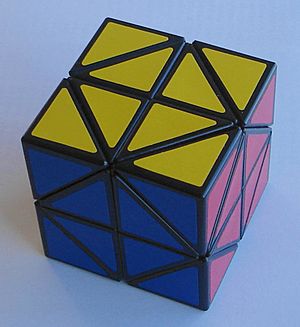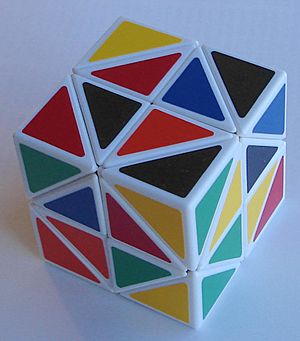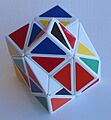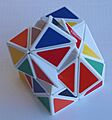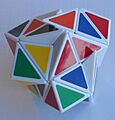Helicopter Cube facts for kids
The Helicopter Cube is a cool puzzle, a bit like a Rubik's Cube. It was invented by Adam G. Cowan in 2005. This puzzle looks like a regular cube, but it twists in a special way. Instead of turning whole faces like a Rubik's Cube, the Helicopter Cube twists around its edges. Your goal is to mix up the colors and then get them back to one solid color on each side.
Contents
How the Helicopter Cube Works
The Helicopter Cube is shaped like a cube. It has 8 corner pieces, each with three colors. It also has 24 center pieces, each with just one color. What makes it different from a Rubik's Cube is that you don't rotate its faces. Instead, you twist the puzzle by turning it around its edges.
When you twist the puzzle by 180 degrees, two corner pieces swap places. Also, two pairs of face center pieces switch around. But the cube still keeps its perfect cube shape. You can mix up the whole puzzle just by using these 180-degree turns.
Jumbling Moves
There's another cool way to twist the Helicopter Cube, called a jumbling move. You can turn an edge by about 71 degrees. This makes some pieces line up with a different edge. Then, you can rotate that second edge. This mixes up the corner and face center pieces, and the puzzle no longer looks like a perfect cube! It gets all bumpy and weird.
When the puzzle is jumbled, some regular twists might not work anymore. If you do a bunch of jumbling moves, you can get the cube back to its normal shape. But sometimes, the center pieces might stick out like spikes instead of lying flat. This means they are in the wrong position.
Different Kinds of Helicopter Cubes
There are a few different versions of the Helicopter Cube:
- The original Helicopter Cube: This one has 8 corner pieces and 24 face center pieces.
- The "Curvy Copter" by Tom van der Zanden: This version has 12 extra edge pieces. You have to solve around these new pieces.
- The "Curvy Copter Plus": Also by Tom van der Zanden, this one has more cuts in the middle of the face center pieces. This allows for even more jumbling!
- The "Helicopter Skewb": Another one by Tom Van Der Zanden. It looks like the original Helicopter Cube, but it can also twist like a Skewb puzzle.
- The "Curvy Copter 3": This version was made in 2014 by mf8.
Solving the Puzzle
If you only use 180-degree twists to scramble the puzzle, then you can solve it using only 180-degree twists. It's pretty straightforward.
However, if you use jumbling moves, solving it gets much harder. Even if you get the puzzle back into a cube shape, you might not be able to solve it with just 180-degree twists. This is because jumbling moves can swap face center pieces that normally can't be swapped with simple 180-degree turns. So, you'll need to use more jumbling moves to get it fully solved.
Images for kids


